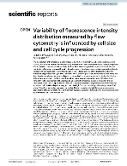Variability of fluorescence intensity distribution measured by flow cytometry is influenced by cell size and cell cycle progression

Author
Fedr, Radek
Kahounová, Zuzana
Remšík, Ján
Publication date
2023Published in
Scientific ReportsVolume / Issue
13 (1)ISBN / ISSN
ISSN: 2045-2322Metadata
Show full item recordCollections
This publication has a published version with DOI 10.1038/s41598-023-31990-1
Abstract
The distribution of fluorescence signals measured with flow cytometry can be influenced by several factors, including qualitative and quantitative properties of the used fluorochromes, optical properties of the detection system, as well as the variability within the analyzed cell population itself. Most of the single cell samples prepared from in vitrocultures or clinical specimens contain a variable cell cycle component. Cell cycle, together with changes in the cell size, are two of the factors that alter the functional properties of analyzed cells and thus affect the interpretation of obtained results. Here, we describe the association between cell cycle status and cell size, and the variability in the distribution of fluorescence intensity as determined with flow cytometry, at population scale. We show that variability in the distribution of background and specific fluorescence signals is related to the cell cycle state of the selected population, with the 10% low fluorescence signal fraction enriched mainly in cells in their G0/G1 cell cycle phase, and the 10% high fraction containing cells mostly in the G2/M phase. Therefore we advise using caution and additional experimental validation when comparing populations defined by fractions at both ends of fluorescence signal distribution to avoid biases caused by the effect of cell cycle and cell size.
Keywords
fluorescence intensity distribution, flow cytometry, cell size, cell cycle progression
Permanent link
https://hdl.handle.net/20.500.14178/2094License
Full text of this result is licensed under: Creative Commons Uveďte původ 4.0 International







